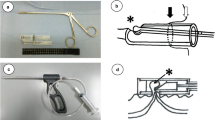Abstract
Conventional acetylcholinesterase (AChE) histochemistry is both time consuming and complicated and requires the mixing of reagents that are toxic to the human body. We developed a rapid technique for performing AChE histochemistry, which has already been published, and now present a kit for performing AChE histochemistry that is a further improvement. Rectal suction biopsy specimens taken from 20 constipated patients and three full thickness biopsy specimens taken from 4 Hirschsprung’s disease (HD) patients during pull-through surgery from aganglionic, transitional, and ganglionic bowel segments were tested using our rapid technique and the new kit. Each specimen was incubated for only 6 min. All ganglion cells stained clearly for AchE in just 6 min using both techniques. However, the kit was able to stain AchE positive nerve fibers more clearly and did not detect endogenous peroxidase-containing histiocytes, as did the earlier rapid technique. The kit could also detect AchE positive nerve fibers in the circular and longitudinal muscle layers, unlike the earlier rapid technique. The kit allows AChE histochemistry to be performed rapidly with complete accuracy, without any risk for toxicity. Moreover, the kit provides more focused information on AchE distribution in the bowel itself without any extraneous staining and can be used for diagnosing HD and allied disorders as well as establishing the exact level of innervation for pull-through resection.



Similar content being viewed by others
References
Karnovsky MJ, Roots LA (1965) A “direct-coloring” thiocholine method for cholinesterase. J Histochem Cytochem 12:219–2212
Lake BD, Puri P, Nixon HH et al (1978) Hirschsprung’s disease. An appraisal of histochemically demonstrated acetylcholinesterase activity in suction rectal biopsy specimens as an aid to diagnosis. Arch Pathol Lab Med 102:244–247
Hedreen JC, Bacon SJ, Price DL (1985) A modified histochemical technique to visualize acetylcholinesterase-containing axons. J Histochem Cytochem 33:134–1404
Hanker JS, Anderson WA, Bloom FE (1972) Osmiophilic polymer generation: catalysis by transition metal compounds in ultrastructural cytochemistry. Science 175:991–993
Kobayashi H, O’Briain DS, Hirakawa H et al (1994) A rapid technique of acetylcholinesterase staining. Arch Pathol Lab Med 118:1127–1129
Author information
Authors and Affiliations
Corresponding author
Rights and permissions
About this article
Cite this article
Kobayashi, H., Miyahara, K., Kusafuka, J. et al. A new rapid acetylcholinesterase staining kit for diagnosing Hirschsprung’s disease. Pediatr Surg Int 23, 505–508 (2007). https://doi.org/10.1007/s00383-006-1849-7
Published:
Issue Date:
DOI: https://doi.org/10.1007/s00383-006-1849-7




